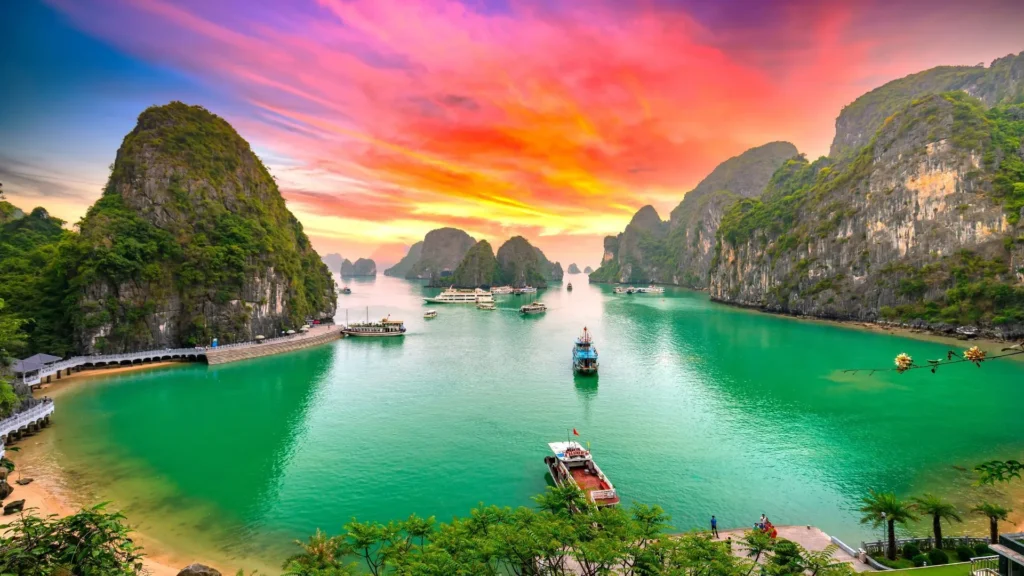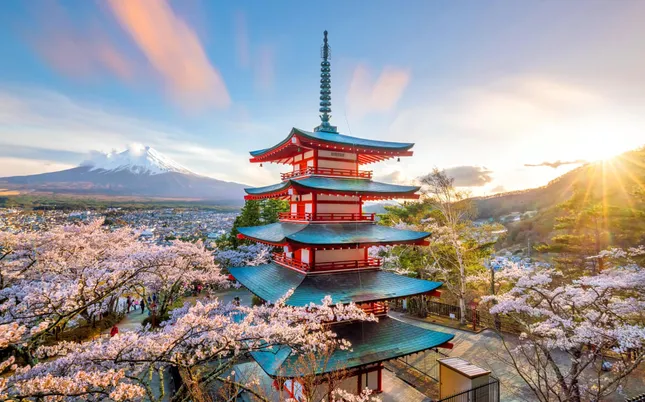I still have it in my mind. When I first got off the plane in Bangkok, I felt like this. The air was thick and humid, full of the smell of jasmine, the sound of a million motorbikes in the distance, and the smell of sizzling street food. It was an overwhelming experience in the best way possible. It was a colorful, chaotic, and beautiful welcome to a continent that would steal my heart and change how I saw the world.
The idea of an “Asia vacation guide” is exciting and terrifying for a lot of people. Asia is huge. From the super-modern skyscrapers of Singapore to the ancient temples of Cambodia that are buried in the jungle, this continent has a lot of different things to see. Choosing where to go in Asia for your first trip can be as hard as picking one grain of sand from the Sahara.
That’s where I come in.
I’ve put together the ultimate guide for you, the first-timer, after ten years of backpacking, hopping between luxury hotels, and everything else on this amazing continent. This is more than just a list; it’s a guide. We’ll look at the best beginner-friendly Asian destinations, go over some useful travel tips for Asia, and find out not only where to go but also how to go so that your first trip is truly magical.
Why Asia? The East’s Appeal to a First-Time Traveler
Before we get into the “where,” let’s talk about the “why.” What makes Asia the best place to go for a life-changing trip?
- Unmatched Diversity: On one trip, you can hike through misty mountains, relax on world-class beaches, visit cities that look like they’re from the future, and walk through ancient historical sites. There is no other place with such a wide range of cultures, religions, and locations.
- The Food Culture: Let’s be honest, this is a big reason. Asian food is its own world. Your taste buds will have the time of their lives, from slurping down a $1 bowl of phở on a tiny plastic stool in Hanoi to enjoying a multi-course kaiseki meal in Kyoto.
- Incredible Value: Even though places like Japan and Singapore can be expensive, most of Asia, especially Southeast Asia, is very cheap. You can go on longer trips and have more fun without spending a lot of money here.
- Deep History and Spirituality: Asia is where the first civilizations began and where the world’s major religions began. You can feel the history when you stand in front of Angkor Wat at sunrise or listen to the morning chants at a Buddhist monastery.
- The People: There is a reason why people think Asians are friendly. The Thai “Land of Smiles” and the warm welcomes you get in a Vietnamese homestay are just two examples of how kind and generous the people are. These will be some of the best memories of your trip.
Are you ready to pack? First, let’s get you ready.
The Pre-Trip Gauntlet: Important Travel Tips for Asia Before You Go
The trip of a lifetime starts long before you get on the plane. Getting ready well is the most important part of having a stress-free adventure. Use this as your basic Asia vacation guide.
Paperwork and visas: the first step that is boring but very important
There is no way to change this. Depending on your nationality and where you’re going, the requirements for a visa can be very different.
- Visa-Free/Visa on Arrival: A lot of Southeast Asian countries let people from certain countries enter without a visa for a certain amount of time (usually 15 to 30 days). Thailand, Malaysia, and Vietnam are some countries that have these kinds of rules. [Source: Look at your government’s official travel advisory website, like the U.S. The Department of State Travel site is [https://travel.state.gov/content/travel/en/international-travel.html].
- e-Visas: Countries like India and Cambodia have made it easier to get a visa by allowing you to apply for one online before your trip.
- Full Visa Applications: If you want to stay longer or go to a certain country, you might have to apply for a visa at an embassy or consulate in your home country.
Tip you can use: Make a spreadsheet with the places you want to go. At least two months before you go, do some research on the specific visa requirements for your passport for each one. Even though they charge a fee, websites like iVisa can make things easier.
Health and Shots: It’s Better to Be Safe Than Sorry
Four to six weeks before you leave, see a travel doctor or clinic. They will have the most up-to-date information on which vaccinations you should get for the areas you plan to visit. Hepatitis A, typhoid, and tetanus are some of the most common vaccines. You might also want to think about getting vaccinated against rabies or Japanese encephalitis, depending on where you’re going.
Don’t forget to bring a basic first aid kit! Add things like
- Pain relievers like ibuprofen and paracetamol
- Antihistamines
- Bandages and antiseptic wipes
- Medicine for motion sickness
- Salts for rehydration (a lifesaver!)
- A doctor-prescribed broad-spectrum antibiotic
Money and Budgeting: Cash Is Still King (Sometimes)
Credit cards are widely accepted in big cities, hotels, and fancy restaurants, but you need cash for street food, local markets, and smaller towns.
- Currency Exchange: Don’t change a lot of money at the airport; the rates are usually bad. When you get there, it’s usually better to take out cash from a local ATM.
- ATM Fees: Tell your bank you’re going to be traveling so they don’t freeze your card. You might want to get a debit card that is easy to use while traveling and doesn’t charge high international ATM fees. Charles Schwab, Revolut, and Wise are all good options.
- Daily Budget: This can change a lot. You can travel comfortably in Southeast Asia (like Vietnam and Thailand) for $40 to $60 USD a day. If you’re going to Japan or South Korea, you’ll need to plan on spending more like $80 to $150 USD per day.
Packing Smart: Less is So Much More
I can’t say this enough: don’t pack too much. You’ll probably buy clothes and souvenirs, and carrying a heavy suitcase through hot, humid streets is no fun.
- The Right Bag: A 40–50 L travel backpack is great for trips with more than one destination. Most airlines will let you bring it on, and it makes you pack light.
- Clothes: Choose fabrics that are light and breathable, like cotton, linen, and merino wool. Put layers in your bag. When you go to temples and other religious sites, make sure to wear at least one conservative outfit that covers your shoulders and knees.
- Must-Haves: A universal power adapter, a portable power bank, a reusable water bottle with a built-in filter, and solid toiletries to avoid liquid restrictions.
The Main Event: Find the Best Places in Asia for Your First Adventure
Alright, the time you’ve been waiting for has come. After talking to a lot of other travelers and going back to the same places many times, I’ve come up with a list of the best places for a first-time traveler that have the right mix of adventure, ease of access, and cultural immersion. This is your main list of places to go in Asia.
1. Thailand: The Perfect Place for First-Time Travelers

Why Thailand Is a Good Place for Beginners to Visit in Asia: Thailand is the most popular way to get to Southeast Asia for a reason. The tourist infrastructure is great, English is spoken in most tourist areas, transportation is quick, and it has a little bit of everything Asia has to offer: busy cities, old temples, lush jungles, and some of the most beautiful beaches in the world.
**Important Places to See:
- Bangkok: The capital that is full of life and chaos. A city with a lot of different things, like shiny mega-malls next to old temples and quiet canals.
- Chiang Mai: The cultural center of Northern Thailand. It’s more relaxed than Bangkok and has a lot of temples, ethical elephant sanctuaries, and great food. It’s also surrounded by mountains.
- The Southern Islands: You can choose! Koh Samui and Phuket are both well-developed and have high-end hotels and nightlife. If you want a more rustic, backpacker-friendly vibe, go to Koh Lanta or Koh Phi Phi. Just be careful of too many tourists.
Things You Have to Do:
- Temple Hopping in Bangkok: The Grand Palace and the reclining Buddha at Wat Pho will leave you speechless.
- Go to an Ethical Elephant Sanctuary: Spend a day bathing and feeding elephants that have been rescued. Do your homework and pick a sanctuary that is really ethical, like the Elephant Nature Park in Chiang Mai. Source: World Animal Protection’s guide to ethical sanctuaries.
- Take a Thai cooking class: find out how to make pad thai and green curry. It will last a lifetime as a souvenir.
A 10-Day Itinerary for First-Timers
- Days 1–3: Bangkok (temples, street food, and markets)
- Days 4–7: Chiang Mai (Fly from Bangkok). Elephants, temples, and a night bazaar
- Days 8–10: Fly from Chiang Mai to Krabi or Phuket. Go to the beach and hop from island to island.
Mai pen rai (which means “it’s okay” or “no worries”) is a great way to learn how to let go of small annoyances. When you’re stuck in traffic or your coffee order is wrong, take a deep breath and say “mai pen rai.” It’s a small change in your mind that will help you be more patient.
2. Japan: The Place Where Things Are Different and the Same
Why Japan Is a Good Place for Beginners: If safety, cleanliness, and efficiency are your top priorities, Japan is the place for you. It may be the safest country in the world, and the public transportation system, especially the Shinkansen bullet train, is known for being on time. The culture is very traditional, but it is also very polite and welcoming to tourists. It’s a look at both the past and the future at the same time.
**Important Places to See:
- Tokyo: The huge, modern city. Tokyo has a neighborhood for every mood, from the crazy neon lights of Shinjuku and the strange clothes of Harajuku to the peaceful Meiji Shrine.
- Kyoto: The old imperial capital and Japan’s cultural heart. There are thousands of temples, geishas in the Gion district, and the famous Arashiyama Bamboo Grove.
- Osaka: This city is a food lover’s dream and is known as “Japan’s Kitchen.” It’s more lively and real than Tokyo, which is known for its street food in Dotonbori.
**Things You Have to Do:**
- Ride the Shinkansen: Just riding the bullet train is an activity in and of itself.
- Stay in a ryokan: Spend the night in a traditional Japanese inn. Sleeping on tatami mats, taking a bath in an onsen (hot spring), and having a multi-course kaiseki dinner are all great ways to experience Japanese culture.
- See the Shibuya Crossing: Check out the busiest intersection in the world in Tokyo. Get a coffee at the Starbucks that looks out over the crossing for a great view.
A 10-Day Itinerary for First-Timers:
- Days 1–4: Tokyo (seeing neighborhoods and taking a day trip to Hakone to see Mt. Fuji)
- Days 5–7: Kyoto (Fushimi Inari Shrine, Gion, and temples)
- Days 8–9: Osaka (Dotonbori food tour and Osaka Castle)
- Day 10: Take a flight home from Osaka (KIX).
Interlink: Are you going to Japan? Don’t forget to read our [Ultimate Guide to Using the Japan Rail Pass].
A Useful Tip for Everyday Life: You can use the Japanese idea of “kaizen,” which means “continuous improvement,” in your own life. Every day, try to make small improvements of 1% in your work, your health, or your relationships. These small changes add up over time to make a big difference.
3. Vietnam: A Beautiful and Strong Country
Why It’s a Good Place for Beginners to Visit in Asia: Vietnam is probably the best place in all of Asia to get a lot of value for your money. The price is just mind-blowing. It’s also very safe for tourists, has some of the best food in the world, and the landscape changes a lot from the karst mountains in the north to the lush Mekong Delta in the south. The country’s long and complicated history makes every visit more interesting.
**Important Places to See:
- Hanoi: The beautiful capital full of scooters. The Old Quarter, Hoan Kiem Lake, and the fact that phở was born here are all famous things about it.
- Ha Long Bay: The UNESCO World Heritage site with emerald waters and thousands of limestone islands that rise high into the sky. A night cruise here is a must-do for anyone visiting Vietnam.
- Hoi An: A beautiful old town with streets lit by lanterns, skilled tailors who can make custom clothes in 24 hours, and a calm, riverside vibe.
- Ho Chi Minh City (Saigon): The busy, modern business center in the south. There are a lot of things to do in this city, like the War Remnants Museum and the Cu Chi Tunnels, which are sad reminders of the Vietnam War.
**Things You Have to Do:**
- Overnight cruise in Ha Long Bay or Bai Tu Long Bay: The second bay is less crowded but just as beautiful.
- Get Tailor-Made Clothes in Hoi An: The tailors here are known for their high quality and quick work. It’s the best souvenir you can wear.
- Explore the Mekong Delta: Go on a boat tour of Vietnam’s “rice bowl,” where you’ll see floating markets and factories that make coconut candy.
**A 12-Day Itinerary for First-Timers:**
- Days 1–3: Hanoi (Old Quarter, food tour)
- Days 4 and 5: Ha Long Bay (cruise overnight)
- Days 6–8: Hoi An (Fly from Haiphong to Da Nang. It’s an old town with a beach and tailors.
- Days 9–11: Ho Chi Minh City (Fly from Da Nang.) Learn about the war and see how people live in the city.
- Day 12: A trip to the Mekong Delta for the day.
Tip for Daily Life: The Vietnamese are very good at being creative, especially when it comes to making the most of small spaces. Take a look around your house. Is there a nook or corner that you could use better? You can use this “resourcefulness mindset” to clean up and enjoy the space you have.
4. South Korea: Where K-Pop and Old Palaces Meet
Why It’s a Good Place for Beginners to Visit in Asia: South Korea is a lively mix of old and new. It’s very safe, and the public transportation is world-class, which makes it easy to get around. This is a must-see for people who love K-pop, K-dramas, and Korean beauty products. But there’s more to see than just pop culture. There are peaceful temples, beautiful national parks, and a food scene that’s full of flavor and very satisfying.
Important Places to See:
- Seoul: The country’s heart. Visit the beautiful Gyeongbokgung Palace, get lost in the traditional Bukchon Hanok Village, shop in the lively Myeongdong district, and eat your way through Gwangjang Market.
- Busan: This busy port city is South Korea’s second largest and has a more laid-back, beachy feel. The Jagalchi Fish Market, the colorful Gamcheon Culture Village, and the beaches (like Haeundae) are all well-known.
- Jeju Island: This volcanic island is known for its unique landscapes, hiking trails (including Hallasan, South Korea’s highest peak), and beautiful beaches. It’s a popular vacation spot for Koreans.
Things You Have to Do:
- Go to the DMZ (Demilitarized Zone): It’s a sobering and interesting look at the war that is still going on between North and South Korea. You can’t learn this history from a book. Source: You must book a tour with an authorized company like Koridoor Tours.
- Have a “Chimaek” Night: This fun Korean tradition includes eating Korean fried chicken (chi) and drinking beer (maek). To get the full experience, go to a spot along the Han River in Seoul.
- Go to a Jjimjilbang (Korean Spa): These traditional bathhouses are open 24 hours a day and are a big part of Korean culture. Use a body scrub to get rid of dead skin, then relax in different saunas or even take a nap.
A 9-Day Look at the First-Timer’s Itinerary:
- Days 1–4: Seoul (tour of the DMZ, markets, palaces, and Gangnam)
- Days 5–7: Busan (Take the KTX high-speed train.) There are beaches, temples, and a fish market.
- Days 8–9: Gyeongju (a day trip from Busan). This was the Silla Dynasty’s capital and is known as the “museum without walls.”
A Useful Tip for Everyday Life: In Korea, jeong (정) is a deep and complicated feeling of connection, loyalty, and love for people, places, and things. It helps people in the community get along better. This week, try to cultivate jeong in your own life. You could have a meal with a neighbor, call an old friend, or just show more appreciation for the people around you.
5. Malaysia: A Real Cultural Mix
Why It’s a Good Place for Beginners to Visit in Asia: Malaysia is a great place to visit if you want to see three cultures at once. The architecture, religion, and, most deliciously, the food all show how different the people are. The country has a mix of Malay, Chinese, and Indian cultures. English is an official language and is spoken by a lot of people, so it’s easy to talk to people. It has a great mix of modern cities, beautiful islands, and lush rainforests.
Important Places to See:
- Kuala Lumpur (KL): The modern capital, which is easy to spot because of the famous Petronas Twin Towers. It’s a great place to shop and eat.
- Penang: A food lover’s dream come true. George Town, the capital, is a UNESCO World Heritage site known for its colonial architecture, colorful street art, and famous street food (hawker stalls).
- Langkawi: An archipelago of 99 islands with beautiful beaches, duty-free shopping, and the exciting Langkawi Sky Bridge.
- Malaysian Borneo (Sabah and Sarawak): For those who want to try something new. There are ancient rainforests, orangutans, Mount Kinabalu, and world-class diving here.
Things You Have to Do:
- Take a food tour in Penang: this is a must. Try some of the local foods, like Char Kway Teow, Assam Laksa, and Roti Canai.
- Go to the Batu Caves: This limestone hill is just outside of KL and has a Hindu shrine and a series of caves. A huge golden statue of Lord Murugan guards the shrine. Get ready to climb the 272 steps that are all different colors!
- Explore the Rainforests of Taman Negara: This is one of the oldest rainforests in the world. Take a boat ride up the river, walk on the canopy, and look for animals.
Itinerary for First-Timers (A 10-Day Look):
- Days 1–3: Kuala Lumpur (Petronas Towers, Batu Caves, and food streets)
- Days 4–7: Penang (Fly from KL. Tour of street art and food in George Town
- Days 8–10: Langkawi (Fly from Penang.) Beaches, a cable car, and time to relax
6. Singapore: A Soft, Green Way to Get to Know Asia
Why It’s a Good Place for First-Timers in Asia: Singapore is the best place in Asia for first-timers. It’s very clean, safe, and efficient, and English is one of its four official languages. It’s a great place to start or end your trip to Asia, even though it’s more expensive than the places around it. It can be a gentle entry point or a comfortable place to get used to things again. It feels like a carefully planned garden, with nature and technology working together perfectly.
Important Places to See:
- Marina Bay: The famous skyline with the Marina Bay Sands hotel, the strange Gardens by the Bay, and the ArtScience Museum.
- Ethnic Quarters: Visit Chinatown, Little India, and Kampong Glam (the Malay-Arab quarter) to see the colorful cultures there. Each one has its own temples, foods, and places to shop.
*Sentosa Island: The city’s “pleasure island,” with Universal Studios theme parks, beaches, and other fun things to do.
Things You Have to Do:
- Marvel at Gardens by the Bay: See the high-tech Supertree Grove and walk through the huge Cloud Forest and Flower Dome conservatories. The light and sound show every night is amazing.
- Eat at a Hawker Center: This is where you can really feel the heart of Singapore. These outdoor food courts have a wide range of tasty and cheap dishes from all over the world. People talk about Lau Pa Sat and Maxwell Food Centre all the time. Source: Singapore’s Hawker Culture is on the UNESCO list of Intangible Cultural Heritage.
- Take a walk through Jewel Changi Airport: Don’t be in a hurry to leave! The Jewel is a tourist attraction in its own right, with the Rain Vortex, the world’s tallest indoor waterfall, surrounded by a lush forest valley.
Itinerary for First-Timers (A 4-Day Look—Great for a Stopover):
- Day 1: Get there, check out Marina Bay, and see the light show at Gardens by the Bay.
- Day 2: Visit the ethnic neighborhoods: Chinatown in the morning and Little India in the afternoon.
- Day 3: Trying out different foods. Eat your way through the Hawker Centers of Maxwell and Lau Pa Sat. Go to the ArtScience Museum.
- Day 4: Before you leave, take some time to enjoy Jewel Changi Airport.
Tip for Daily Life: Singapore’s success is based on careful long-term planning and making green spaces in a crowded city. This idea of “biophilic design,” which means bringing nature into our spaces, has been shown to lower stress and improve health. Put some plants on your desk or in your home office. Instead of at your desk, go to a park nearby for your lunch break. It’s a small change that was inspired by Singapore that can have a big effect.
Your Complete Guide to Asia: Last-Minute Tips for a Trip You’ll Never Forget
You know where you’re going, but that’s not the end of the advice. These are some general travel tips for Asia that work in most places.
Get used to the squat toilet
Yes, you will see them, especially in rural areas, bus stations, and older buildings. Don’t be afraid of it! It’s often cleaner because you don’t touch anything. Always have a small pack of tissues and hand sanitizer with you because there isn’t always toilet paper available.
The Art of Haggling (Politely)
In most Asian markets (with the notable exceptions of Japan and Singapore), prices can be haggled over. Haggling is a part of the culture and can be a fun way to talk to people.
- Do: Be friendly, smile, and know what you want to pay.
- Don’t be rude or start at a price that is way too low. A good place to start is to offer 50% to 60% of the original asking price and then meet in the middle.
- Know when to stop. If a vendor won’t lower the price to one you’re happy with, it’s okay to politely say no and walk away. They might even call you back with a better deal!
Stay in touch with SIMs and eSIMs
It’s easy and cheap to stay connected. When you get to your destination, don’t pay for an expensive international plan from your home provider. Instead, get a local SIM card at the airport. If you want even more convenience, think about getting an eSIM from a company like Airalo or Holafly. You can install it on your phone before you leave home. This lets you get to your data right away when you land.
Be a Responsible Traveler
Travel is a privilege, and with that privilege comes responsibility.
- Cut Down on Plastic: Bring a reusable water bottle and a shopping bag with you.
- Support Local: Eat at restaurants owned by families, buy from local artists, and hire local guides.
- Be kind to animals: don’t ride elephants. Pick sanctuaries that are moral. Don’t buy things that are made from animal products.
- Ask Before You Photograph: Always ask before you take close-up pictures of people, especially kids or monks.
Your Adventure Is Waiting
Taking the first step is the hardest part of any trip. Going to Asia might seem like a big step, but it’s a step into a world of amazing warmth, beauty, and experiences that will change the way you see things.
You’re not just going to a new place; you’re making memories that will stay with you forever when you eat ramen in Tokyo, watch the sun rise over Ha Long Bay, or haggle for treasures in a Bangkok market. These beginner-friendly Asian destinations are only the beginning. When you land, take a deep breath of the humid, fragrant air and let the adventure begin.
Questions That Are Often Asked (FAQ)
Q1: Which Asian country is the best for a first-time visitor?
A: Thailand is often ranked as the best all-around choice for a first-timer, even though it’s a matter of opinion. It has the best mix of things to do, like beaches, cities, jungles, and history, as well as easy travel, low prices, and a friendly culture. It’s the best way to learn about the amazing things in Southeast Asia.
Q2: Is it safe for a woman to travel alone in Asia?
A: Yes, most of the time. A lot of Asia, especially Japan, South Korea, Singapore, Vietnam, and Thailand, is thought to be very safe for women traveling alone. Be aware of your surroundings, don’t walk alone at night in dark places, trust your gut, and let someone know where you’re going. These are all standard safety tips. Every year, a lot of women travel alone in Asia and have amazing adventures.
How long do I need to plan my first trip to Asia?
A: To do it right, I think you should spend at least two weeks on it. This lets you really get to know one country or get a taste of two different parts of the same country, like North and South Thailand. You could easily visit two countries, like Vietnam and Cambodia or Malaysia and Singapore, if you have three weeks to a month to spare.
Q4: Do I have to learn the language of the area?
A: You don’t have to be fluent because most major tourist areas speak English. But learning a few important phrases shows respect and will help you have more real conversations. If you can say “Hello,” “Thank you,” and “Delicious” in the local language, you’ll get a lot of smiles.
Hello: Sawasdee krab/ka (Thai), Konnichiwa (Japanese), and Xin chào (Vietnamese)
Thank you: “Khop khun krab/ka” in Thai, “Arigatou gozaimasu” in Japanese, and “Cảm ơn” in Vietnamese




